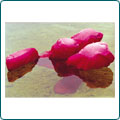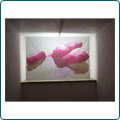|
HOMUNCULUS UND OPHELIA
Objekt: ortsbezogene Objekte
Maße: Foto: 210 x 135 cm
Objekt: ca. 80 x 80 x 15 cm
Material: Fotografie auf Textil
Stretchstoff, Sand, Glasplatte
Ort: Ganserhaus, Kunstverein Wasserburg
Datum: April 2007
Das auf Textil gedruckte Foto spannt sich in eine Nische des Raumes und bildet so, von hinten beleuchtet, einen „natürlichen“ Leuchtkasten. Das Objekt auf der Fotografie erstreckt sich vom Grund des Sees bis über die Wasseroberfläche, auf der es durch Luftkissen zum Schwimmen kommt. In seiner starken Farbigkeit und ungewöhnlichen Form springt das Motiv zwischen konkretem Objekt und Abstaktion hin und her.
Das Objekt auf der Glasscheibe befindet sich auf dem Boden, durch das Gewicht des Sandes und seine Eigenschaft als rinnendes, sich der Greifbarkeit entziehendes Material impliziert. Die geometrische und symmetrische Grundform des Objekes findet Parallelen in der Architektur, vor allem aber in der Biologie. Das Objekt spielt mit den Eigenschaften der inneren Bestandteile eines Körpers und seiner externen, eventuell orthopädischen Ergänzung.
OPHELIA UND HOMUNCULUS implizieren den Übergang von der Lebendigkeit eines Körpers zu seiner bloßen Objekthaftigkeit als tote Masse und von toter Materie zu einem künstlich erzeugten, lebendigen Körper.
In der Präsentation der Arbeiten auf dem Boden und in erhöhter Position wird dieses Wechselspiel installativ aufgegriffen.
HOMUNCULUS AND OPHELIA
Object: Site-specific objects
Material: Photography on textile, fabric, sand, glass
Size: Photo: 210 x 135 cm
Object: approx. 80 x 80 x 15 cm
Location: Ganserhaus, Kunstverein Wasserburg
Date: April 2007
The photo is printed on the sheet and – spanned over a corner of the room and illuminated from behind – forms a “natural” light box.
The object in the photo reaches from the floor of a lake to the surface, where, thanks to air cushions, it swims lightly. Bearing intense colours and having an exceptional shape, the item goes back and forth between concrete object and abstraction.
The material of the object placed on the glass forces it to stay on the floor. Because of its weight and structure, the sand inside tends to run downwards and evade availability. The basic symmetric shape of the object is paralleled in architecture and even more so in biology. The object plays with the characteristics of a body’s inner elements and potential external, orthopaedic supplements.
OPHELIA UND HOMUNCULUS implies the transition from a living body to a mere objective representation and from inanimate matter to an artificially-created living body.
The presentation of the objects on the floor and on different levels mirrors this interplay by means of the installation.
|
|








